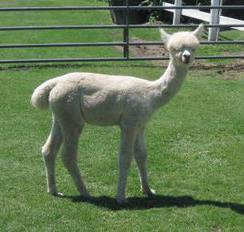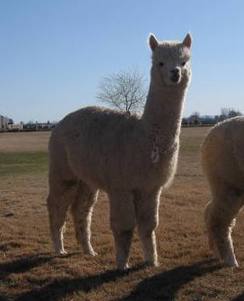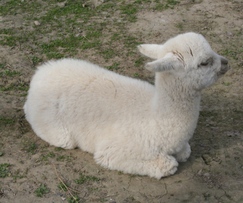|
April 06, 2013
What Should You Put in the Cria Baby Bottle?
Conventional wisdom says cow or goat milk is a good substitute. My research indicates neither of those are the most optimum milk substitute.
By: Sheila Scroggins

Undersized at 1 year of age

Normal size & development at 2 years of age

Mom did help out no signs of Beserk Male.
Recently, we bottle fed a cria for 2 months with a unique formula which produced good results. I pursued further research to see if my choices of formula had real validity. I had read in multiple sources that cow’s milk was one of the acceptable choices for supplementation. I did however, not feel comfortable with that choice. As a Nurse Practitioner, I knew pasteurized cow’s milk as a sole source of nutrition has its limitations. Numerous sources recommended adding yogurt to increase the protein content in cow’s milk, but both products have nearly identical protein and fat concentrations.(3) I couldn’t see that adding yogurt would actually increase protein concentrations since both have similar raw percentages. I did see the benefit in adding yogurt for its microbe benefits.
Our dam had previously lost a cria to sepsis and dehydration the year prior. We were worried from the onset that this dam may have had lactation problems with her first cria. Her second cria arrived and we monitored weights every 12 hours in the first 2 days. Just as we had suspected the dam’s milk production was insufficient and by 48 hours after birth we knew we were going to have to supplement. Initially the dam was checked and she did appear to be producing colostrom in the first 12 hours. As is our routine, the cria received fresh frozen bovine colostrom.
The cria was supplemented in the first month with 5 to 10 percent of body weight volumes of milk depending upon the prior days weight gain. The dam was clearly producing milk but vacillated from day to day and never sufficient amounts to attain a .25 to .50 pound daily weight gain. We were fighting to maintain growth, but attempting not to supplement in excess of what the dam was producing to insure continued dam milk production.
After two weeks the dam was started on domperidone. Domperidone was administered at the recommended dosing and intervals for the next 21 days. During this domperidone dosing period we did see a steady increase in cria weight with a corresponding decrease in supplemental volumes of milk. This steady improvement in lactation on the part of the dam continued until two months after birth at which time we had gone from a maximum of 40 ounce of milk a day down to 5 ounces with adequate weight gains. At two months we ceased supplementing entirely.
(Unable to reproduce table in this document the author refers you to her original article located at her website colusariversidealpacas.com)
Table 2 compares different mammalian milk contents by species. (1)(3) As you can see the protein content in Alpaca milk compares best with that of sheep.(1)(3)(15)(16) Table 2 also evidences one of the poorest equivalency in protein between cow and alpaca milk. I doubt anyone would disagree with the premise that protein content in milk for the growing cria cannot be overstated. In looking at milk replacement formulas effectiveness we cannot just look at simple weight gain when supplementing. We must also be judicious in supplementing with a milk formulation that has sufficient protein level for optimum growth and development of a rapidly growing cria. (11)(4) (5)
Dr. Robert Van Saun in his article, “How Well are they Growing” writes that we have little objective data on the ideal composition of alpaca weight gain. He concludes in his article that this lack of information limits our “ability to generate models capable of estimating amounts of nutrients required in support of growth.”(4) I would agree with Dr. Van Saun in his remarks, but believe we can, with some basic comparisons make informed choices in cria formulations with the knowledge of basic alpaca milk composition. A study out of Chili in 2003 measured the protein content of Alpaca milk between 6.0 and 7.0 Grams and was used as my basis of comparison.(15)
It seems a reasonable assumption that feeding simple cow’s milk, even with the addition of yogurt would provide significantly less protein, less than 50% of the physiological growth needs of the very young alpaca. This substantial depletion of protein content in the rapidly growing cria could certainly result in growth retardation. Therefore, I would say that cow’s milk should not be our exclusive choice for supplementation and especially not for a cria that is being totally bottle fed.
In Table 2, carbohydrate formulations in all species with the exception of humans are similar to the alpaca. (3)(11)(15)(16) Fat content is very similar between goat, cow and the alpaca. (16) The only significant variation that differs greatly between the lamb’s milk formulation and Alpaca’s is the fat content. The table comparison ratios lead me to believe, the best selection would be the sheep formulations. A potential problem is that Manna Pro’s Calf Manna lamb formulation used for this comparison has excess fat in its formulation for the alpaca. Contrary to some of the literature on alpaca requirements, Grober Nutrition’s commercial alpaca milk replacement formulation has nearly the equivalent amount of fat as Manna Pro’s lamb formulation.
For our cria, lamb’s milk was not used exclusively, instead a combination of cow’s milk with a fifty percent ratio to lambs milk. This provided an increase in protein concentration but also effected a lowering of the fat content. The 3rd ingredient was plain yogurt. In the first two weeks, we also added one ounce of fresh frozen bovine colostrom to each of 4 to 5 bottles daily.
Many owners, including us, give bovine colostrom in the first 24 hours after birth. There may be a benefit for the cria to continue to receive colostrom in the first few weeks after birth in the cria that is bottle fed.(2)(7)(10)(14) In human clinical trials, oral doses of hyperimmune bovine colostrom has shown significant promise in treating and preventing bowel infections in young children as a substitute for antibiotics. (14) The first dose of colostrom we gave was to promote IgG passive transfer but the dosing for the first 14 days was to protect the cria from any bowel pathogens that had the potential to cause diarrhea or sepsis in this potentially susceptible cria.
The Journal of Animal Science authors wrote in 2009, “Increasingly, immune components from colostrums and milk are being exploited commercially as antimicrobial agents. Moreover, vaccination procedures to boost the natural concentrations of immune components offer great potential in the development of hyperimmune milk-derived products for prophylactic or therapeutic use in humans.” “The most important pathogen that concentrated bovine colostrom when introduced into the bowel can provide a degree of protection against is the clostridium family of pathogens.” (2) Medical evidence is accumulating that bovine colostrums that is hyperimmune, as a result of multiple frequent vaccines,
serve as a prophylaxis treatment against pathogens. In particular bowel parasites and pathogens seem susceptible to this new unique therapy. 2)(7)(10)(14)
Dairy cows are probably the most hyperimmune mammal because their milk is used for human consumption. Fresh first milking dairy colostrom would be considered hyperimmune simply because of the numbers of immunizations that are used routinely in dairy cattle. (6)(9)(11) Some of the same bowel parasites in alpacas can also be found in the bovine. An example of one pathogen would be the Bovine Viral Diarrhea Virus (BVDV). (2) To my knowledge there is no research into the use of hyperimmune bovine colostrom in the newborn cria to date. However, there is also no reason to believe the promising research to date on hyperimmune bovine colostrums’ application in humans disease prevention can’t also be applied to use in the alpaca.
Use of fresh bovine colostrom does come with some risk. (8)(12) One of those risks could be transmission of Johne’s disease which is a serious untreatable disease in the bovine. The prevalence of Johne’s disease in dairy cattle is not clearly known, but we do know that it can be transmitted through colostrom if the sample is from an infected cow.(8) Many dairy farms have stringent prevention programs for Johne’s disease and some dairy farms screen their cattle for Johne’s disease. Some farms can and do certify their dairy cattle are Johne’s free. (12) If you decide to use fresh frozen bovine colostrom it would be prudent to procure that colostrom from a dairy farm that has a Johne’s certification or only buy colostrom from a verified Johne’s free animal.
More information and product availability is definitely warranted for a readily available cost effective alpaca milk replacement formulation specific for the species. Grober manufacturers actually does produce an alpaca milk formula utilized by zoos and exotic animal farms. The wholesale cost of the alpaca replacement milk is $2.58 per pound, which does not include freight charges. (13) Gober requires a minimum order of 200 pounds of product. The price per pound of Grober’s milk does equal that of the common lamb milk such as Calf Manna at $2.50 per pound. Grober’s minimum order volume requirement makes ordering for the small alpaca farmer not realistic. However, the formula volumes could be shared among multiple ranches or certainly be an option for large ranches.
As a nurse practitioner, I caution new parents who are not breast feeding, not to feed their newborn cow’s milk in lieu of infant formula. I think the same recommendation is applicable to the parents of a newborn alpaca.
I would like to give a special acknowledgment to Scott Haskell DVM, MPVM, PHD, for reviewing this article, being a colleague and my resource for everything veterinary. A special Thanks to Dominic Dawson DVM, DACVIM, for her contributions to this article.
About the Author: Sheila Scroggins and her husband are the owner of Colusa Riverside Alpacas of Northern California. Sheila is a Nurse Practitioner who has been practicing nursing for over 30 years. She is Professor of Nursing for Yuba College, and presently is Director of Nursing. She invites you to visit her web library at www.colusariversidealpacas.com and read her other publications.
Post script: It has now come to my attention that Grober is producing a milk replacer specific for the alpaca in single animal size quanities and are available online through a number of vendors.
References
|